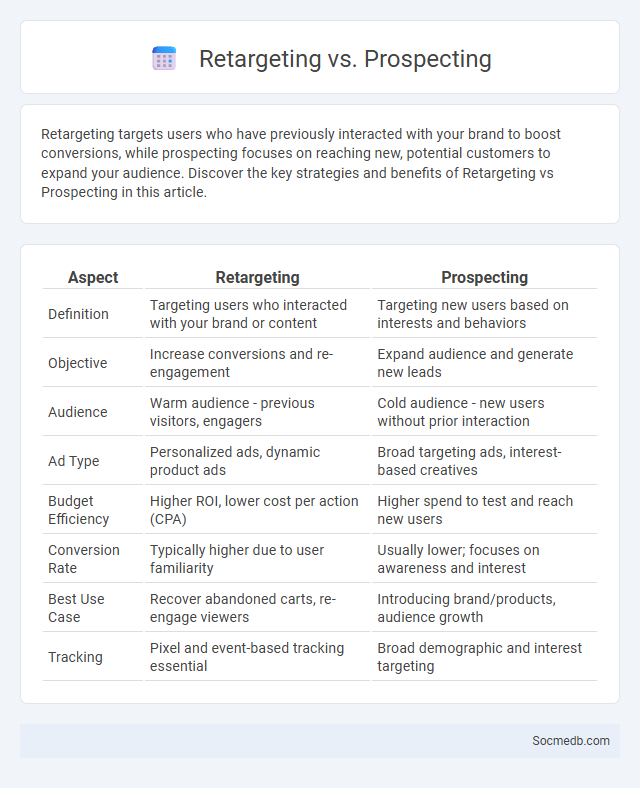
Photo illustration: Retargeting vs Prospecting
Retargeting targets users who have previously interacted with your brand to boost conversions, while prospecting focuses on reaching new, potential customers to expand your audience. Discover the key strategies and benefits of Retargeting vs Prospecting in this article.
Table of Comparison
| Aspect | Retargeting | Prospecting |
|---|---|---|
| Definition | Targeting users who interacted with your brand or content | Targeting new users based on interests and behaviors |
| Objective | Increase conversions and re-engagement | Expand audience and generate new leads |
| Audience | Warm audience - previous visitors, engagers | Cold audience - new users without prior interaction |
| Ad Type | Personalized ads, dynamic product ads | Broad targeting ads, interest-based creatives |
| Budget Efficiency | Higher ROI, lower cost per action (CPA) | Higher spend to test and reach new users |
| Conversion Rate | Typically higher due to user familiarity | Usually lower; focuses on awareness and interest |
| Best Use Case | Recover abandoned carts, re-engage viewers | Introducing brand/products, audience growth |
| Tracking | Pixel and event-based tracking essential | Broad demographic and interest targeting |
Introduction to Digital Marketing Strategies
Digital marketing strategies leverage social media platforms like Facebook, Instagram, and LinkedIn to increase brand visibility and engage target audiences effectively. Your campaigns should incorporate content creation, audience segmentation, and data analytics to optimize reach and conversion rates. Understanding algorithms and trends on each platform enhances the overall impact and return on investment.
Understanding Retargeting: Definition and Importance
Retargeting is a digital marketing strategy that targets users who have previously interacted with Your social media content or website, increasing the likelihood of conversion. By displaying tailored ads to these users, retargeting improves brand recall and drives sales efficiency. Understanding the importance of retargeting helps maximize your social media advertising ROI through personalized, timely engagement.
What Is Prospecting in Digital Advertising?
Prospecting in digital advertising involves targeting new potential customers who have not previously interacted with a brand, aiming to increase brand awareness and expand the customer base. Using data-driven insights and audience segmentation, advertisers create tailored campaigns that reach users based on demographics, interests, and online behavior across social media platforms. Effective prospecting leverages tools like Facebook Ads Manager and Google Ads to optimize reach and engagement, driving higher conversion rates and business growth.
Audience Targeting Explained
Audience targeting in social media involves identifying and reaching specific groups based on demographics, interests, behavior, and location to optimize ad performance. Platforms like Facebook, Instagram, and LinkedIn offer advanced targeting tools that allow you to customize campaigns for your ideal customer profiles. Effective audience targeting maximizes engagement, improves conversion rates, and reduces ad spend by focusing Your marketing efforts on the most relevant users.
Key Differences: Retargeting vs Prospecting vs Audience Targeting
Retargeting specifically targets users who have previously engaged with Your brand, increasing conversion rates by reminding interested prospects. Prospecting aims to reach brand-new potential customers based on demographic, behavioral, and interest data, expanding Your audience base. Audience targeting leverages detailed segmentation to deliver personalized ads to defined groups, enhancing relevance and engagement across social media platforms.
Benefits of Retargeting for Conversions
Retargeting on social media platforms significantly boosts conversions by reconnecting with users who have previously engaged with Your website or content, increasing the likelihood of completing a purchase. These targeted ads personalized to the user's interests and behaviors improve brand recall and drive higher click-through rates. Leveraging advanced data analytics, retargeting maximizes advertising ROI by focusing your budget on high-intent audiences, making your marketing efforts more effective and efficient.
Effective Prospecting Techniques for New Customer Acquisition
Effective prospecting techniques on social media involve leveraging targeted content and personalized outreach to identify and engage potential customers. Using advanced analytics tools, you can analyze user behavior and preferences to refine your audience targeting, increasing the likelihood of conversions. Consistent interaction through comments, messages, and tailored offers builds trust and enhances Your chances of acquiring new customers efficiently.
How Audience Targeting Enhances Campaign Precision
Audience targeting leverages demographic, behavioral, and psychographic data to deliver tailored social media content that resonates with specific user segments. By utilizing platform algorithms and advanced analytics, marketers can optimize ad placements, increase engagement rates, and reduce wasted ad spend. Enhanced precision in audience targeting directly contributes to higher conversion rates and improved return on investment (ROI) for social media campaigns.
When to Use Retargeting, Prospecting, and Audience Targeting
Retargeting is most effective for engaging users who have previously interacted with your website or social media content, increasing conversion rates by reminding warm leads. Prospecting targets new potential customers by leveraging lookalike audiences and interest-based criteria to expand reach and build brand awareness. Audience targeting capitalizes on detailed demographic, behavioral, and psychographic data to deliver highly personalized ads that resonate with specific segments of your market.
Conclusion: Choosing the Best Approach for Your Goals
Selecting the optimal social media strategy depends on clearly defined goals such as brand awareness, lead generation, or customer engagement. Leveraging analytics tools on platforms like Facebook, Instagram, or LinkedIn allows for data-driven adjustments that maximize ROI. Tailoring content to target audiences while monitoring performance metrics ensures sustained growth and effective resource allocation.
 socmedb.com
socmedb.com